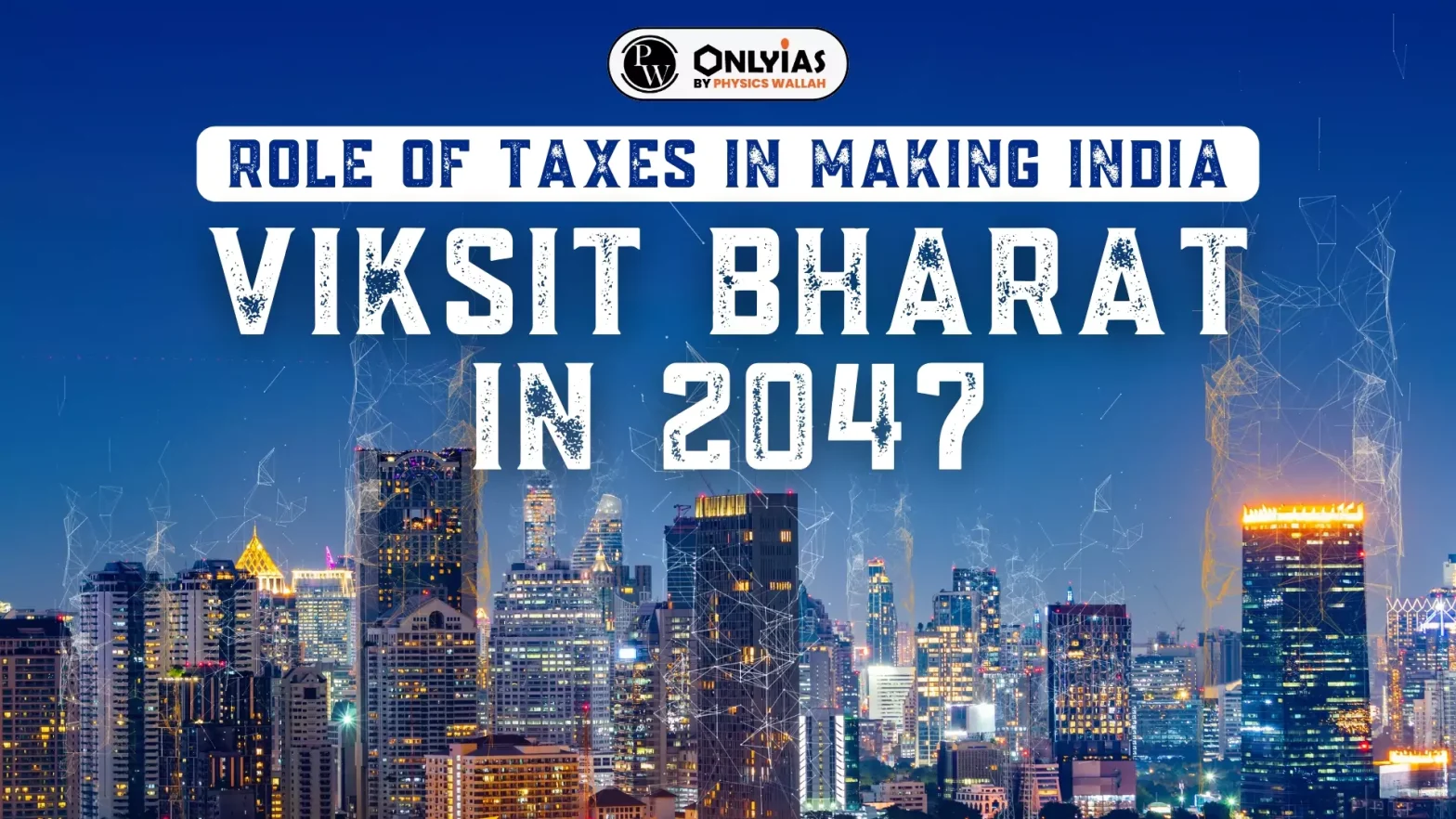Context
Taxes simply do not provide resources for development and for expanding social agenda of the government but play a crucial role in stimulating savings, making investments and activities that promote development.
Role of Taxes in Making India Viksit Bharat in 2047
- Economic Objective of India: For a developing country like India, economic growth and development remains a major macroeconomic objective.
- Responsibility of the Government: Governments are saddled with the responsibility of providing public goods like, Health, education, transport, and social welfare along with basic infrastructure for the citizens to improve their quality of life.
- Role of Taxation: The ability of the government to live up to these responsibilities largely depends on the amount of resources generated by it through taxation.
- Role of Tax Incentives and Holidays: Tax incentives and tax holidays among others can attract foreign investors to a country.
- Responsibility of citizens: Taxes legitimately belong to the citizen of a country and if somebody is not paying his due share, he is letting down the people as well as the country and is not fulfilling the legal and moral duty cast upon him.
- Automation in Taxation Process: The tax departments (CBDT & CBIC) are fully automated, with all tax processes being digitalized, completely removing the human interface.
- Benefits of Automation in Taxation:
- This has also reduced the cost of compliance at the end of a taxpayer, thus creating efficiency, transparency, and accountability.
- This promotes ease of doing business to improve overall economic progress, development and well-being.
- It helps in removing poverty, raising living standards, and increasing per capita incomes and overall Indian GDP.
- Collection of Taxes: CBDT, collected Rs 19.58 lakh crore in taxes in 2023-24, showing a growth of over 18 per cent, even surpassing the revised tax collection target of Rs 19.45 lakh crores, in a fair and transparent manner.
- The CBIC, has also shown good progress and mobilised increased taxes from GST, including highest ever mobilization of Rs 2,10,000 crores in April 2024.
- It is expected that as the economy becomes more formalised and broad-based, more taxes will come through income taxes.
- Tax to GDP ratio of India: Another important dimension is the tax GDP ratio of India, which is presently at about 18.5 per cent (including the state taxes) is slightly lower as compared to similarly placed economies.
- Suggestions to Improve Tax to GDP ratio: Noted economist, Govind Rao (2017) states that this should have been at a level of about 20 per cent by now, the major thrust for which has to come from direct taxes, ratio of which is presently at 6.6 per cent.
- Future Projections: It is expected that in a couple of years, the direct taxes ratio would increase to 7 per cent and gradually to 8 per cent, with indirect taxes chipping in at about 6% and state taxes ratio at about 6.5 per cent of GDP.
- Measures to Increase Taxation: The use of technology; digitalization, computerization and automation, in capturing economic transactions from different sources, 360-degree profiling of taxpayers
- The use of technology AI-ML in the identification of non-filers and tax evaders is going to play a prominent role in this.
- Shifting of MNC to Low Tax jurisdiction: In the last few decades, it was seen that some of the multinationals were not paying their fair share of taxes by resorting to shifting their profits to low-tax jurisdictions.
- Challenge of Digitalization: The digitalization of economies further compounded the efforts of countries to raise fair taxes as a company can do business, without being present in a country.
- Digital Tax by India: India brought on statute provisions of equalisation levy in the year 2016 initially to tax digital advertisements, which was later extended to sales-purchase of commodities or provision of services in the year 2020, popularly called as digital tax.
- Addressing the Shifting of Profit challenge: In the meanwhile discussions were taking place in OECD, UN and G-20 to address this situation, wherein India contributed significantly
- Robust GDP Growth: In the year 2023-24, the growth of Indian GDP has been robust and is estimated to be about 7.8 per cent, that too against tough economic conditions worldwide, because of disruptions in supply chains on account of the Russia-Ukraine conflict on one hand and Israel-Hamas war on another.
- Expected Indian GDP Growth: With macroeconomic fundamentals strong, it is expected that in 2024-25, Indian GDP may grow at the rate of 6.8 per cent to 7 per cent.
- Reforms after Elections: The prime minister has already hinted about the big-ticket reforms expected to be undertaken immediately after elections, so as to build the country for the next 1,000 years.
Enroll now for UPSC Online Course
Conclusion
The vision for next 25 years has been prepared by the NITI Ayog, the policy think tank of the country and all ministries have prepared a 100 days programmes, as also next five years project schedule, to make India Viksit Bharat by 2047.
Enroll now for UPSC Online Classes
![]() 28 May 2024
28 May 2024

